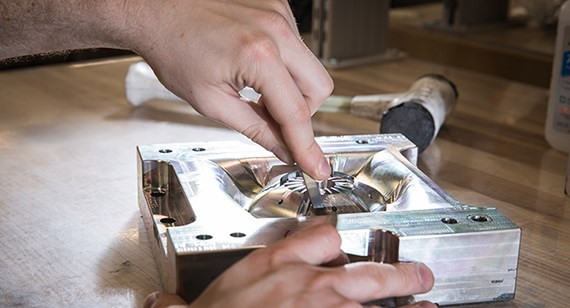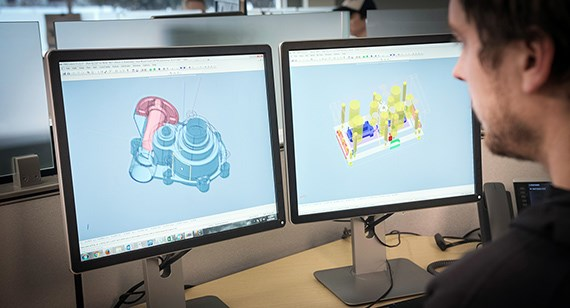Deciding whether and when to invest in production tooling is no simple matter. For starters, there’s the initial investment cost, which in some cases might exceed that of a luxury sports car. Add to that the months of waiting, the risk of downstream design changes, associated rework costs (assuming rework is even possible), and the potential that, at least in the short term, you may have to order more parts than are currently needed. Plus, what if the product doesn’t sell?
Of course, a well-thought-out prototyping process reduces many of these concerns, but you’ll still grapple with fickle market demands and the possibility of higher-than-desirable inventory levels—never mind tying up funds on a tool with a questionable ROI. Many might opt to stick with the tried and true prototype mold, eating the higher cost per part and pushing the tool further than is desirable in an effort to delay the production mold decision.

There is another option at FacFox. It’s called on-demand manufacturing, and it straddles the fence for injection molding customers who aren’t quite ready to pull the trigger (and may never need to) on a production mold, but who have steady low-volume production needs beyond prototyping. It offers a long-term injection molding option with a substantially lower cost of ownership. The risk goes down and flexibility goes up.
When deciding if an on-demand manufacturing option for molding is right, ask yourself these qualifying questions:
- Design: Are there different part design requirements for low-volume production, and if so, what do I need to know?
- Product Lifespan: What is my expected product cycle and part volume?
- Cost: Will I pay more for on-demand versus prototype tooling, and how will this impact the per-piece price?
- Inspection Reporting: Do my parts have inspection requirements and what level of documentation is needed?
Design: Minor Caveats to Consider
Because on-demand molds are expected to last longer than prototype molds, the usual rules of injection molding design are enforced a bit more stringently, where lifetime production is usually well beyond 2,000 shots.
By comparison, an on-demand mold is guaranteed for life. As long as it’s used at least once every three years, it will remain available and can even be repaired or replaced the mold at no additional cost. In return, however, FacFox suggests the following guidelines be adhered to when designing parts for on-demand molds.

Small or delicate part features might be okay in prototype volumes, but are more prone to failure at higher volumes and repeated use, especially when considering that on-demand molds are occasionally family molds, able to produce up to eight parts per shot. Simply put, molds must become more robust as part volumes increase.
Similarly, things like narrow slots, fillets near shutoffs, overly thick or thin cross-sections, and sharp areas in the mold cause grief that might be manageable when making a handful of parts, but is more difficult to deal with on larger part quantities. Pay close attention to the design for manufacturability (DFM) analysis that accompanies your quote and be sure to address any problem areas before moving forward with an on-demand mold order.
An adequate draft is also key. Less than optimal part ejection and manual part removal is no big deal on a prototype order, but “sticky” molds add avoidable production time when molding thousands of parts. Vertical faces should have at least 1 degree, with an additional 2 degrees beyond FacFox’s prototype draft angle recommendations. Shutoff and core pin design is also more critical with on-demand molds—consult with your FacFox applications engineer for design help in these instances.
Aside from these caveats, little else has changed. Most FacFox molds are still made of aluminum. Part tolerance remains the same as with prototype and on-demand molds (+/-0.003 in. plus ≥0.002 in./in.), as does the array of material choices. The same surface finish and texturing options are still available. And undercuts, wall thicknesses, corner radii—all should be respected, just as before.
Product Lifespan: Low-Volume Help as You Ramp-Up Production
Still, you should leverage prototype molding when proving out designs and need to minimize initial investment. On-demand molds are best suited for when you’re further along in product development or need bridge tooling for end-use parts at the lowest possible cost as you ramp-up to full production volumes. And if you never do achieve those volumes, that’s okay too. It’s your mold, FacFox will maintain it for you and deliver parts quickly when you need them—a low-volume production option that tempers the potential risk of demand volatility inherent with traditional molding.
Cost: Bottom Line Issues to Consider
Yes, things will cost a bit more upfront depending on part complexity and the number of cavities (up to eight), but still nowhere near the investment you would otherwise have to make for production parts. The good news is that the price per piece is often substantially lower with on-demand molds compared to prototype mold, even if you want to order small quantities every week or two. The other good news is that, if you’re undecided, you can proceed with a prototype mold and when you find that the part design is stable and the volumes warrant it, you can upgrade to an on-demand mold and pay only the difference between the different mold offerings.
Quality Documentation: Covering Inspection Reporting Requirements
Here’s another big piece of the injection molding puzzle. An increasing number of companies, especially those in the automotive, medical, and aerospace industries, require various levels of quality documentation, including material certifications and inspection reports. As such, FacFox is offering several ways to meet these inspection needs with on-demand manufacturing option:
- A quality inspection report is offered at no additional cost. It covers 3 plane-to-plane or OD (outer diameter) measurements, and is automatically included with all on-demand orders (and prototype orders upon request).
- FacFox’s digital inspection report uses an automated high-speed 3D scanner to verify up to 12 measurements, such as OD/ID (outer and inner diameter) plane-to-plane, and hole locations. There is an additional charge, but a discount is available if your CAD file contains Product Manufacturing Information (PMI) data.
- The conventional inspection report supports the widest variety as well as an unlimited number of measurements, but is the most expensive inspection option and can add up to five days of lead time to on-demand products. For those who have extremely thorough inspection requirements, conventional inspections work well and satisfy most First Article Inspection (FAI) requirements.
Many of FacFox customers have found that on-demand manufacturing is an excellent fit for their post-prototyping needs. There’s no need to invest big bucks upfront, part costs are much lower, and you can still have parts in your hands within days. If you think your project might be a good candidate, don’t hesitate to upload your CAD file.